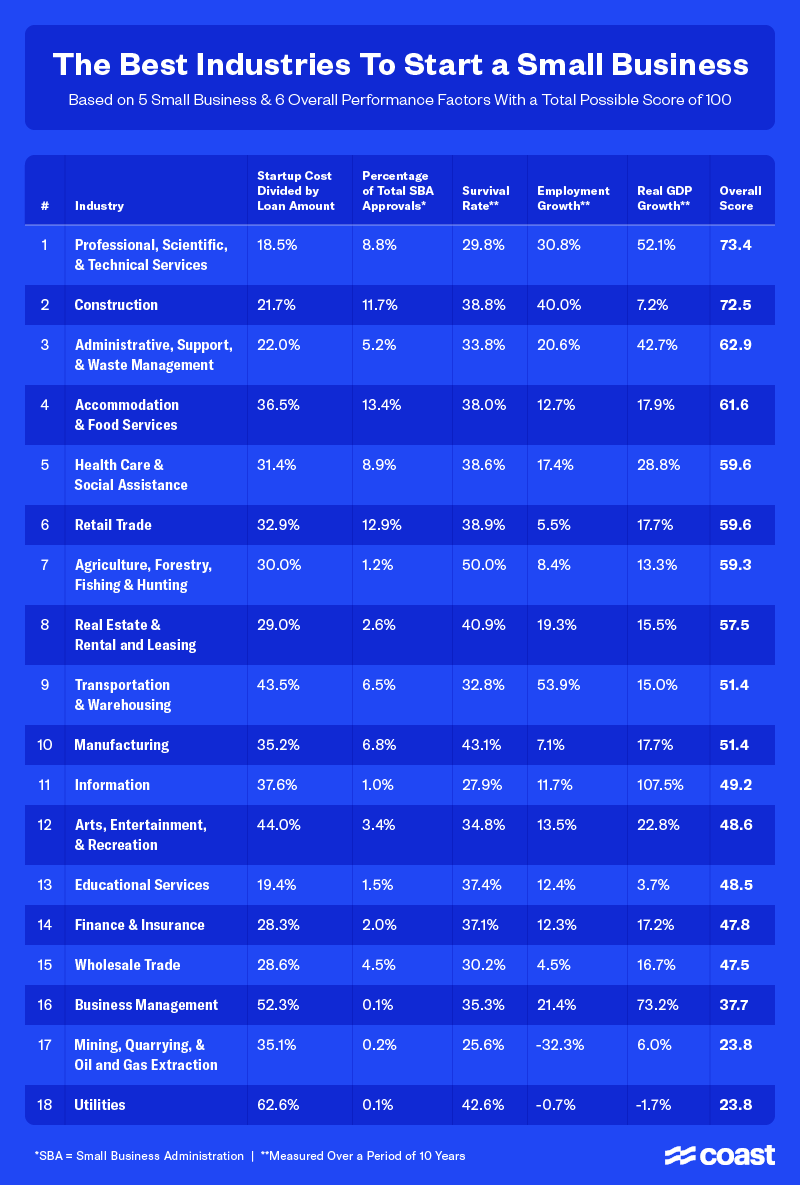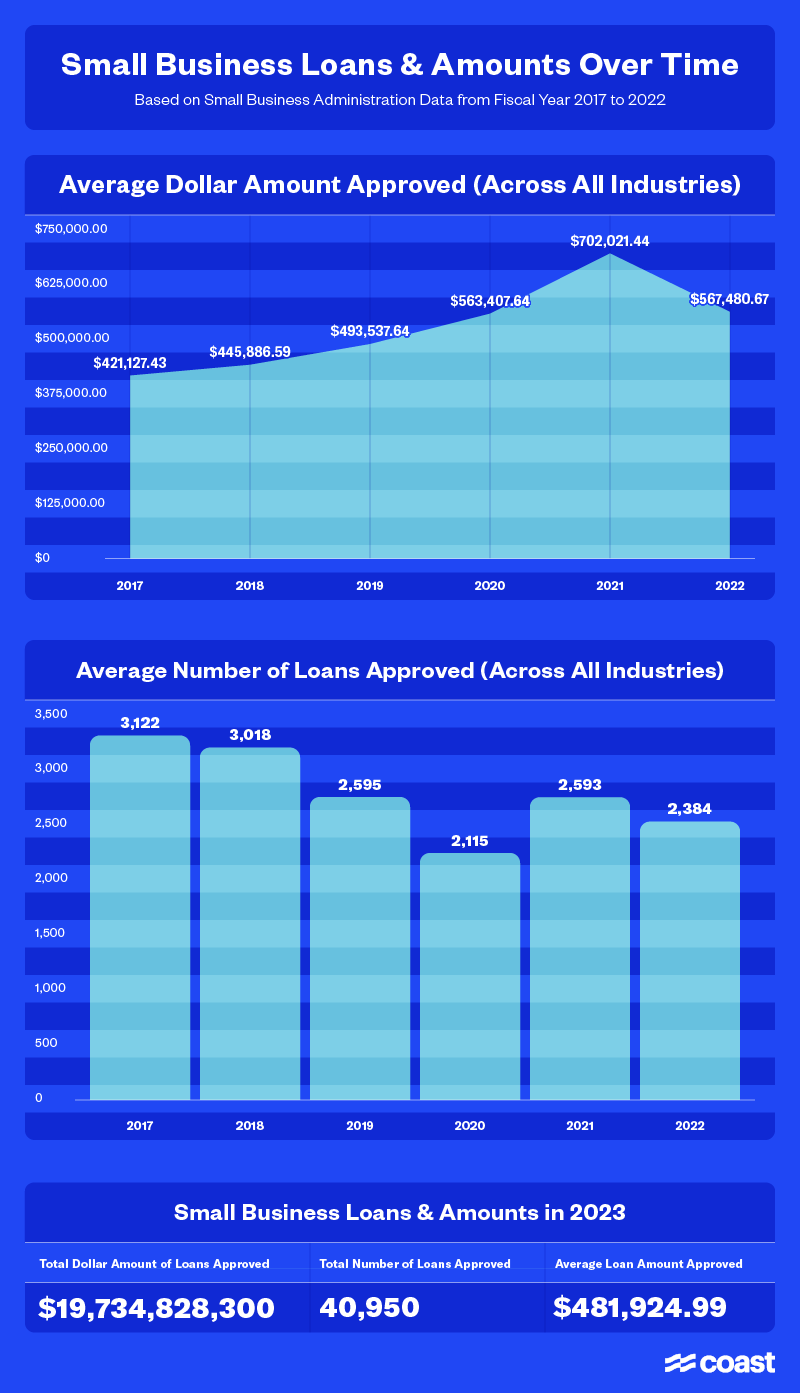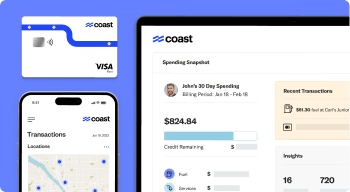In 2023, small businesses continue to be the foundation of the U.S. economy. Recent research tells us that an impressive 90% of Americans want to be their own boss, and nearly half of all U.S. employees (49%) work for a small business.
However, some industries fare better than others when it comes to opening a small business, especially when considering factors like average startup costs, SBA loan approval rates, profit margins, and market trends.
Read on to learn more about how these factors and many more play a role in what makes small businesses thrive (or fail) across numerous industries and to find out the best industries to start a small business in 2023.
Key Findings
- The top two industries to start a small business in are professional, scientific, and technical services, and construction. The third best is administrative, support, and waste management services.
- The average Small Business Administration loan across all industries in 2023 is $498,902.
- The information industry saw the highest increase in 10-year real GDP growth with a growth rate of 108%, compared to the national average of 26.3% across all industries.
Ranking the Best Industries To Start a Small Business

When starting a small business, the industry you enter can be a make-or-break decision. Below are the four best industries to consider when starting a business, based on growth rates, startup costs, and their share of small business administration loans.
The professional, scientific, and technical services sector is home to companies that perform services in any of the three categories and typically require a high degree of expertise and training. It’s a wide-ranging sector that encompasses businesses that perform legal, accounting, architecture, research, and advertising services, among others. It also takes the top spot for a number of reasons.
First, the average startup costs in this sector are only 18.5% of the average small business administration loan size, making it relatively accessible for aspiring entrepreneurs who may not have deep pockets.
Additionally, this sector has shown robust economic vitality, witnessing a 52% increase in real GDP growth from 2012 to 2022.
Construction is the second-best industry to start a small business in 2023. One of the most compelling reasons is its small business employment share, which stands at 82.3—the second-highest in our study. This means that over 80% of those employed in this sector are done so by small businesses, highlighting the significant role small businesses play. Also, the average startup costs are the lowest among the industries evaluated, at just $67,349.
Administrative, support, and waste management ranks third, driven by its impressive real GDP growth of 42.7% and an employment growth rate of 20.6% from 2012 to 2022.
Both figures are above the industry average, making it a sound choice for potential business owners looking for industries with strong future growth prospects.
Last but not least is the accommodation and food service industry. This sector accounts for an average of 13.4% of small business administration loans and secures 18.7% of the total loan dollars annually.
These numbers indicate strong financial backing, making it a viable option for entrepreneurs looking for industries with access to ample funding opportunities.
The Factors That Impact Small Business Success
Our study focuses on several key metrics (displayed above), highlighting what makes small businesses thrive or falter. These metrics include the 10-year survival rate, employment growth, and new business applications.
The 10-year survival rate often reflects an enterprise’s resilience and ability to maintain strong customer relationships. In other words, these are the industries where businesses are most likely to succeed in the long run.
We also looked at employment growth and real GDP, as these factors provide insights into an industry-wide ability to hire and sustain a talented workforce and signal a healthy industry ripe with opportunities for small businesses.
Finally, new business applications within industries could signify a positive economic outlook or forewarn of intensifying competition. Understanding these rates can help future business owners identify the opportunities and challenges they may face along the way.
Small Business Administration Loan Data Over Time

One of the most noticeable shifts in Small Business Administration (SBA) loan trends occurred in 2020, when the average number of loans approved dipped to 2,115, down from 2,595 the previous year.
In 2021, however, the number of loans approved returned close to pre-pandemic levels at 2,593, while the average dollar amount approved per loan significantly jumped to $702,021. This jump suggests that although there was a comparable number of loans, each loan was, on average, much larger—likely a response to increased business costs.
Fast-forward to 2023, and the data so far (through August) indicates an average of 2,354 loans approved with an average amount of $10,233,387.92. These figures suggest that the loan landscape is stabilizing, albeit at a slightly lower level than the peak years.
Both loan counts and amounts appear to be on a path of relative consistency, suggesting a more predictable environment for entrepreneurs seeking financial support.
Historical SBA loan data can provide aspiring business owners the context they need to understand current opportunities and challenges, especially when looking at financing options. Considering these trends is crucial when contemplating which industry to enter and what kind of financial backing may be available.
Going forward, the major takeaway for entrepreneurs looking at their next business venture is that SBA loan approvals numbers and amounts will likely stay stable. This gives those who are seeking funding a more concrete idea of what to expect when it comes to the SBA loans they apply for.
Closing Thoughts
The entrepreneurial journey is full of numerous possibilities and pitfalls. However, looking at previous SBA trends can provide a guiding light for aspiring business owners, offering a glimpse into industries ripe for opportunities. These insights are actionable indicators that help aspiring business owners plan, invest, and grow a successful small business.
Navigating through the intricacies of launching and maintaining a small business is no small feat, but it becomes easier when your financial logistics are all in one place.
That’s where Coast can help.
With our single-card solution, managing fuel, fleet, and employee expenses has never been more straightforward. In industries like construction and transportation, where efficiency is crucial, a one-card system is a game-changer.
With enough data and the right tools, you can make informed decisions that propel your small business toward success.
Methodology
To determine the best industries to start a small business in 2023, we began with a list of 18 sectors (excluding only “Public Administration” and “Other”) and ranked them from 1 to 18 based on 10 different factors that would be important for an entrepreneur to consider when making such a decision.
We then assigned weights to each factor depending on how directly it would impact someone starting a small business. Data points that are more directly related to small business success (such as average startup costs/average small business loan approval amount, small business employment share, and 10-year real GDP growth) received a higher weight than data points that are less related to small business success (such as the 10-year change in business applications and 10-year wage growth).
Based on the weighted index, each industry received a score of 0 to 100, with a score of 100 representing perfect conditions.
| Data Point | Source |
| Avg. SB Loan Approvals Size | SBA |
| % of Total SB Loans Approved (Count) | SBA |
| % of Total SB Loans Approved ($) | SBA |
| Employment Share | SBA |
| Private Sector Survival Rate | BLS |
| Private Sector Employment Growth | BLS |
| Real GDP Growth | FRED |
| Increase in New Business Applications | FRED |
| Avg. Startup Costs | Lending Tree |
| Wage Growth | BLS |


